Slow Cooker Cabbage Soup: Hearty, Simple, and Full of Flavor

Hi — I’m Chef Marcus, and I’m here to make a case for cabbage soup.
Not the crash diet version. Not the “you’ve got five dollars ‘til payday” version. I mean real cabbage soup — slow-cooked, built with depth, layered flavor, and warmth that holds up past the second spoonful.
It’s the kind of dish people forget about until they need it. Maybe it’s cold out. Maybe the fridge is looking empty. Maybe you’re just tired and want something that simmers all day and feeds everyone without a second trip to the store. Whatever the reason, cabbage soup shows up. And if you do it right, it tastes like more than what it’s made of.
- Foreword: The First Time I Made It
- What Cabbage Soup Actually Is (and Isn’t)
- Choosing the Cabbage (Yes, It Matters)
- Building the Base — Broth, Tomatoes, Aromatics
- Seasoning It Like You Mean It
- When to Add the Cabbage (and How Not to Overcook It)
- Add-Ins That Work — And the Ones That Ruin It
- Cook Time and Temperature — Letting It Go vs. Knowing When to Stop
- Serving, Topping, and the Bowl Itself
- Leftovers, Freezing, and Next-Day Flavor
- FAQ — Slow Cooker Cabbage Soup
- Closing: Cabbage Soup Isn’t Fancy — But It’s Real
- Closing: Cabbage Soup Isn’t Fancy — But It’s Real
- Closing: Cabbage Soup Isn’t Fancy — But It’s Real
Foreword: The First Time I Made It
I made cabbage soup the first time because I had a head of cabbage I forgot about and no plan. I chopped it up, dumped it into the slow cooker with a few cans of tomatoes and some vegetable broth, and let it run all afternoon. When it was done, it looked like soup. It smelled like soup. But it didn’t taste like much. It was hot, sure. It was filling. But it was also watery, bland, and thin in a way that made me feel like I’d done something wrong — which I had.
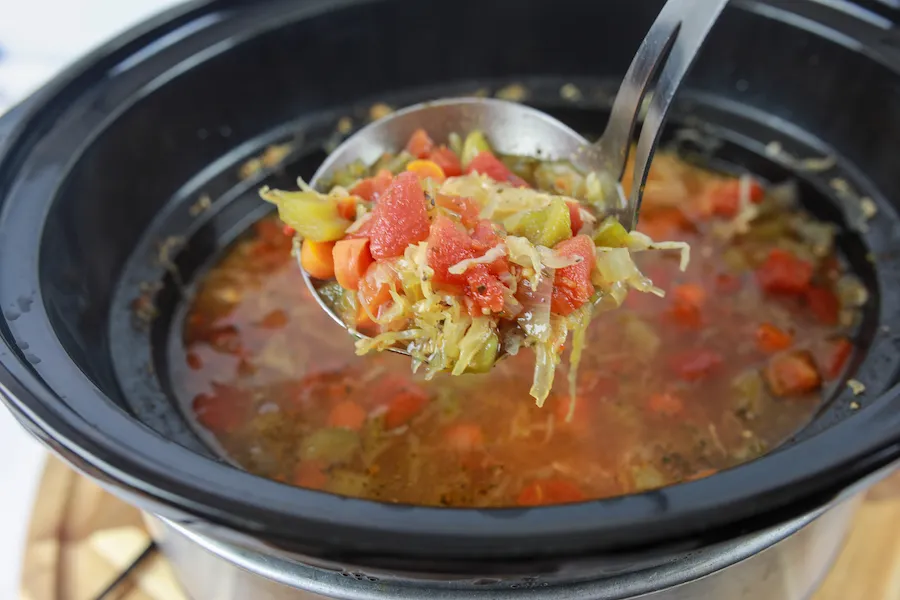
What I’d made wasn’t soup. It was cabbage floating in hot tomato water.
So the next time, I treated it like something worth cooking. I browned the aromatics first. Used better broth. Salted the cabbage at the right time. Balanced the acid. Added enough fat to carry the flavor, but not so much it stopped being clean. And when I tasted that version — same cabbage, same pot, just better choices — it finally made sense.
Since then, I’ve cooked cabbage soup every which way. Vegetarian, meaty, spicy, brothy, hearty. It’s not just a back-pocket meal anymore. It’s something I reach for when I want dinner that doesn’t ask much but still pays off. So if you’ve got a head of cabbage, a slow cooker, and a day where you don’t want to babysit the stove — let’s make a soup that earns a second bowl.
What Cabbage Soup Actually Is (and Isn’t)
Cabbage soup has a reputation — and not always a good one. For some people, it’s tied to old-school diet fads, the kind where you eat it for a week and swear off vegetables forever. For others, it’s just “something Grandma used to make” — basic, brothy, and usually too soft by the time it hit the table.
But at its best, cabbage soup is nothing like the versions people try to forget.
Done right, it’s warm, savory, and simple in a good way — the kind of thing that gets better the longer it sits, that fills a cold kitchen with real comfort, and that doesn’t need cheese, cream, or a garnish to justify itself (though a little bread on the side never hurts). It’s not flashy. It’s not precious. But it is a complete meal when the broth has depth, the cabbage still has some life to it, and the seasoning actually brings it home.
It’s not just hot water with vegetables. It’s not the kind of thing you dump in a pot and forget for eight hours and hope it magically turns into soup. Like most slow cooker meals that taste good, it needs some intention up front — aromatics that matter, salt added at the right time, a broth that’s been given a little help.
And it’s not locked to any one version. Cabbage soup can go in a dozen directions — tomato-heavy or clear broth, loaded with beans or light with greens, with sausage, or chickpeas, or just a lot of garlic and black pepper and the kind of broth you want to drink straight from a mug.
What it is is a blank slate with a backbone. A soup that can feed four people with a head of cabbage and a couple pantry odds and ends, and still taste like you had a plan. The kind of dish that doesn’t try to impress, but ends up doing it anyway.
Next: choosing the right cabbage — because not all of them hold up to slow cooking, and the kind you grab can either give you soft, sweet strands that catch the broth or soggy bits that disappear halfway through the bowl. Let’s make the right cut.
Choosing the Cabbage (Yes, It Matters)
The first few times I made this soup, I used whatever was cheapest at the store. Sometimes it was green cabbage, sometimes red, once even Napa because it looked good that day. But I learned quick: the kind of cabbage you use in a slow cooker absolutely affects how the soup turns out.
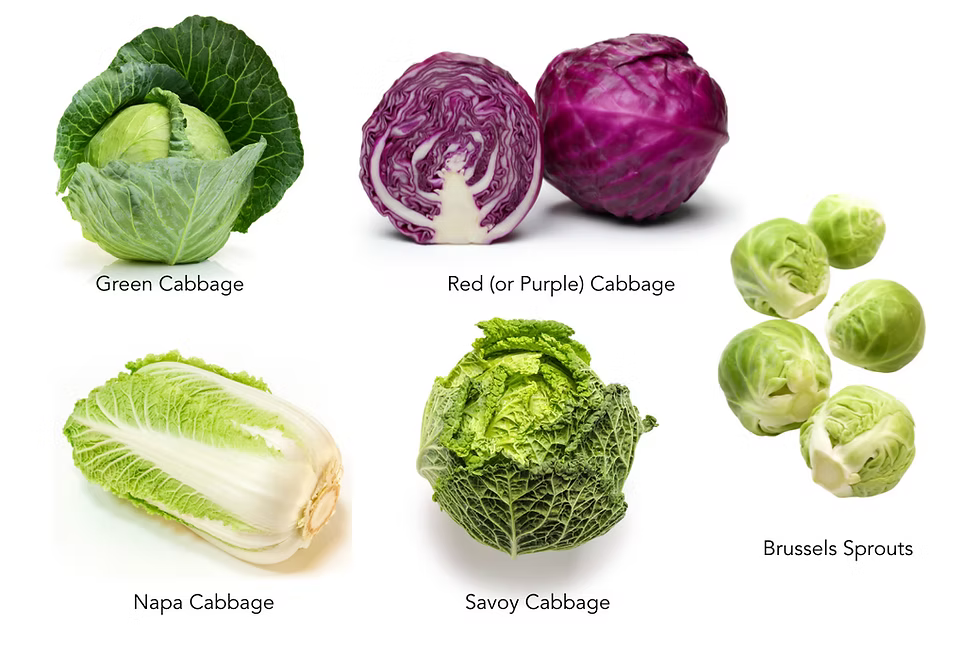
Green Cabbage
This is your default — the one you see most often at the grocery store. Tight head, pale green leaves, crisp and sturdy when raw. It’s built for heat. When slow cooked, it softens into sweet, mellow ribbons without falling apart completely. It holds its shape, so you can still get a bite that feels like something. If you’re making cabbage soup and you’re not sure where to start, start here.
Red Cabbage
Visually, it’s great — deep purple, almost floral-looking in the pot. But slow cook it for hours and that color bleeds out into the broth, turning everything murky. Texture-wise, it’s similar to green, maybe a touch firmer. Still usable, but I’d save red cabbage for slaws, quick sautés, or soups you don’t plan to let ride in a slow cooker all day.
Savoy Cabbage
Lighter, frillier leaves. It has more character raw, but it doesn’t hold up quite as well under long cooking. If you use it, cut it big and add it midway through the cook. Otherwise, it breaks down fast and gets stringy. Flavor’s nice, though — a little nuttier than standard green.
Napa or Bok Choy
Skip these for long cooks. They’re delicate, better for quick simmered soups or stir-fries. If you add them early, they vanish. If you add them late, they float awkwardly and never really settle in. If you’re using them at all, it’s for a final flourish — not the backbone of the dish.
How to Prep It
Start by halving the cabbage through the core. Then quarter it and cut out that dense, white triangle of stem — it’s tough and doesn’t break down well. From there, it depends on how you want the final texture.
- Chopped into large chunks? You’ll get soft, rich bites that feel more like stew.
- Thinly sliced or shredded? You’ll get more silkiness, more integration into the broth — almost like a noodle.
Keep in mind that cabbage shrinks. A lot. What looks like too much raw will cook down into something totally manageable. One medium head (about two pounds) is usually perfect for a full slow cooker batch.
What matters is cutting it to how you want it to finish. Too small, and it disappears. Too big, and it never quite softens right.
Let’s move into the base — the foundation that decides whether your soup tastes like a meal or like hot cabbage water with good intentions. Because no matter how much you slow cook it, if you don’t build it right at the start, cabbage soup will always taste like what people think cabbage soup tastes like. And that’s not a compliment.
Building the Base — Broth, Tomatoes, Aromatics
If you’ve ever made a soup that smelled promising but tasted like it was missing… something, odds are it started with a weak base. Cabbage won’t carry the flavor on its own. It softens, sweetens, soaks up what’s around it — but it doesn’t drive the bus. That’s the job of what goes in first: your broth, your aromatics, and whatever you’re using to give the soup its backbone.
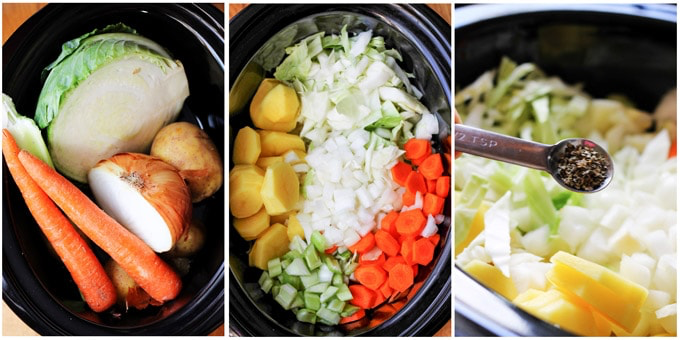
Broth
You can use vegetable broth, chicken broth, or beef — but they’re not interchangeable. Each one shifts the whole vibe of the soup.
- Vegetable broth keeps things light, which is good if you’re going for clean, simple comfort. But most store-bought versions are weak — they taste like carrots and celery dust. So if that’s your base, you’ll need to help it out.
- Chicken broth is the middle ground. It’s savory without being heavy. Great for everyday soup. Use the good kind or doctor the cheap kind with onion, garlic, or a parmesan rind.
- Beef broth makes the soup darker, heavier, and earthier — closer to a stew than a brothy bowl. It can be excellent, especially with tomato-heavy versions, but it’s not subtle.
Regardless of what you choose, make sure it’s not bland. A weak broth is a hole you’ll spend the rest of the recipe trying to crawl out of.
Tomatoes
Some cabbage soups skip them entirely, but if you’re using them, you’ve got options — and they matter.
- Crushed tomatoes give you body and tang. They dissolve into the broth and add depth without taking over.
- Diced tomatoes stay chunky and give you texture. If you want little bursts of acid and structure in the bowl, use these.
- Tomato paste adds richness. Use it in small amounts to deepen the flavor of weak broth. It’s not for color — it’s for umami.
- No tomatoes? Totally fine. But then your broth has to work harder — and so does your seasoning.
Aromatics
This is where most “just throw it in the pot” cabbage soups fall flat. Aromatics aren’t optional. They’re what make this soup, not just cabbage stew.
Start with a base of:
- Onion (yellow or sweet, chopped)
- Garlic (minced or crushed — lots of it)
- Celery and carrot (classic combo, cut small so they don’t dominate)
You can sauté them first if you’re not in a rush — and if you are, at least pile them into the bottom of the slow cooker so they get the most contact with heat early on.
Aromatics don’t just flavor the broth — they make it feel like something’s been cooking all day, even if it’s only been a few hours.
This is the part of the recipe where everything that follows either works or struggles to catch up. Build a base that smells like something, tastes like something, and feels like a place cabbage wants to hang out.
Seasoning It Like You Mean It
I’ve had cabbage soup that looked great — glossy broth, bright vegetables, steam curling up from the bowl — and then the first spoonful just fell flat. It wasn’t bad, it just… didn’t go anywhere. No lift. No low notes. No reason to keep eating except that it was warm and in front of me.
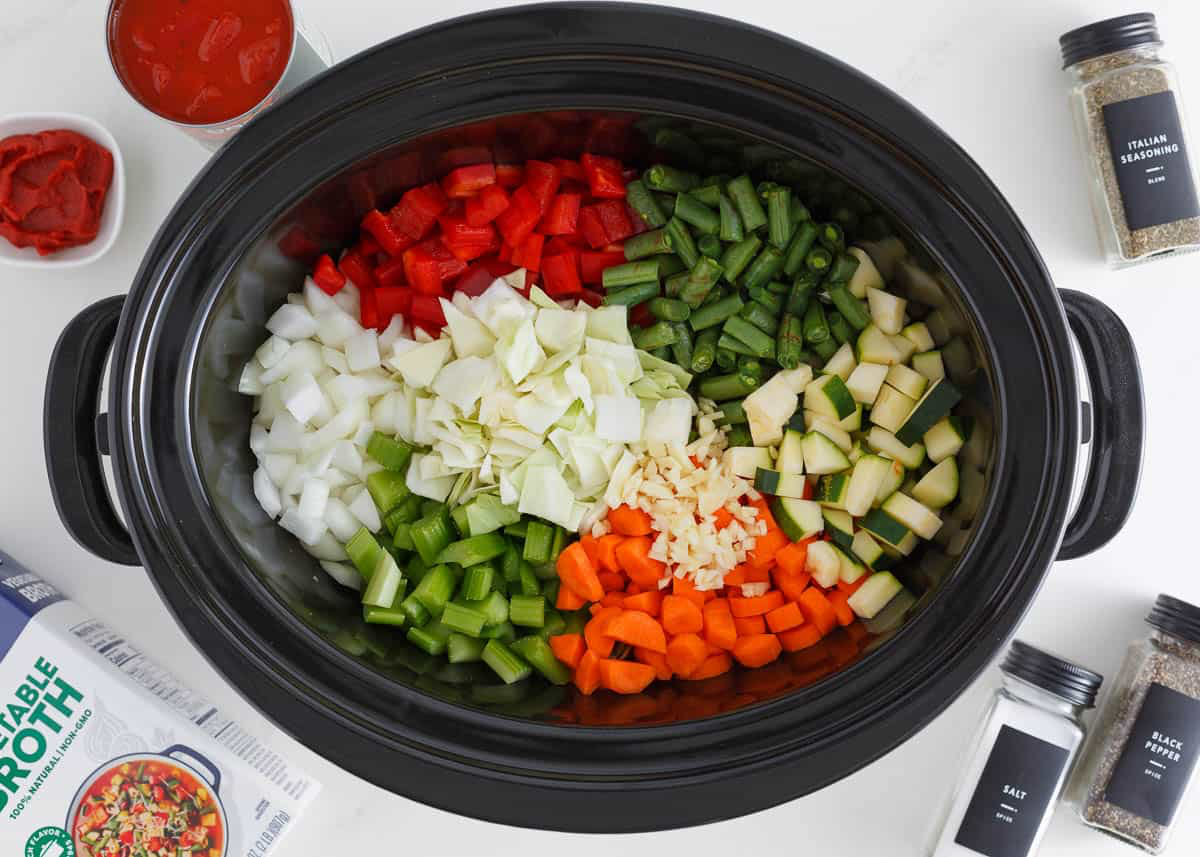
Here’s how to not end up with that.
Salt
Salt is where most people either panic or overdo it. Cabbage wants salt. It’s bland and a little sweet on its own, and without enough seasoning, it fades into the background.
But if you add all your salt up front — especially with a boxed broth that’s already salted — you lose control. The cabbage softens, the water evaporates, and suddenly everything’s too much.
So: salt in stages. Add a little with the aromatics. Taste again after a few hours. Finish with more if needed. You’ll almost always need more — but let the cook guide you, not your measuring spoon.
Herbs
Don’t overthink the herbs. Cabbage soup isn’t meant to taste like an herb garden. You’re looking for warmth, not perfume.
Start with:
- Bay leaf — one or two, added early
- Thyme — dried works fine; don’t use fresh unless you’re adding it at the end
- Parsley or dill — save those for finishing
Skip the rosemary unless you’re pairing with beef broth or sausage. It’s too strong. And basil or oregano will push the soup into tomato-sauce territory unless that’s what you’re after.
Acid
This is what makes cabbage soup taste alive. The catch is when to add it.
A splash of vinegar (apple cider, white wine, red wine) or lemon juice at the end of cooking brightens the whole pot. Add it early, and it flattens. Add it late, and the flavors lift.
You don’t need much — a teaspoon or two is often enough. It’s not to make the soup sour. It’s to wake up the broth after hours of slow heat.
Heat
Optional, but useful. Black pepper always belongs. Red pepper flakes if you want warmth without spice. A little cayenne if you want people to blink on the second bite.
Hot sauce? Great move — but not into the pot. Let each person add their own. It gives the soup more flexibility, and it keeps the base balanced.
Sugar
This one’s controversial. But sometimes — especially if you’ve got a very acidic tomato base or bitter broth — a pinch of sugar balances it out. Not to make it sweet. Just enough to keep the acid from dominating.
The seasoning in cabbage soup isn’t about flash. It’s about depth. Salt to bring it forward. Acid to sharpen. Herbs to carry the middle. Pepper to finish. Do that right, and even the most basic bowl suddenly feels like it came from somewhere.
Let’s move into cabbage timing — because throwing everything in at once might be easy, but it’s also how you end up with soup that tastes like it’s already been reheated before you even serve it.
When to Add the Cabbage (and How Not to Overcook It)
The first time I made cabbage soup in a slow cooker, I followed the laziest logic possible: put everything in at once, stir, lid on, walk away. Eight hours later, the cabbage had completely collapsed. The flavor was fine, but the texture was all one note — soft, limp, and a little too close to overcooked noodles. The whole thing tasted… tired.

What I learned is that cabbage doesn’t need to spend all day in the pot. In fact, unless you want it to fully melt into the broth, it’s better if it doesn’t.
If you want that classic soft-cabbage feel — sweet, silky, the kind that sinks when you stir — sure, put it in at the beginning. Low and slow for 6–8 hours will take it there. But don’t expect it to hold its shape. You’ll get flavor, not texture. That’s fine, if you want broth-forward soup with less chewing and more sipping.
If you want cabbage that still feels like cabbage — soft, yes, but with a little bite left in it — add it midway through the cook. At the 3-hour mark on high, or around hour 5 on low. That way it still cooks down, soaks in the broth, sweetens slightly — but it doesn’t vanish into the background.
Cut size matters, too. Big chunks take longer and hold more texture. Thin ribbons go soft fast. If you want cabbage that almost replaces noodles in the bowl, slice it thin. If you want spoonfuls where the cabbage stands out, cube or rough chop it. Either way, aim for consistent sizing so you don’t end up with a mix of mush and raw edges.
And then there’s the smell. Let’s not pretend it’s not a factor.
Cabbage in a slow cooker is going to smell like… cabbage in a slow cooker. It’s not bad, but it’s not subtle either. Crack a window. Turn on the fan. If you really want to cut the intensity, a splash of vinegar or lemon juice near the end of the cook actually tames the aroma a bit. So does finishing the soup uncovered for the last 20 minutes.
The key is knowing what kind of soup you want before you throw the cabbage in. Because once it’s in, the clock starts — and it’s easier to cook it more than to undo it.
Add-Ins That Work — And the Ones That Ruin It
Cabbage soup doesn’t need much to be filling. But if you want to take it beyond cabbage and broth — give it more protein, more body, or something to chew on — there’s a smart way to do it, and a bunch of ways that just make it feel like a fridge dump.
Beans
White beans (like cannellini or great northern) are the best fit. They’re soft, but they hold their shape. They soak up broth without falling apart. Chickpeas work, too — especially if you want a little chew. Lentils? Yes, but add them early, and expect them to thicken the broth. Red lentils melt. Green or brown ones hold better.
Avoid: overcooked canned beans dumped in at the start. They’ll go mushy fast. Add those during the last hour so they warm through without disintegrating.
Potatoes
They can work — but they’re risky. Cut them too small or leave them in too long, and they’ll soften into the broth and turn the soup starchy and heavy. Best bet is waxy potatoes (Yukon gold, red) cut into chunks. No peeling, just rinse and cube. Add early for full softness, midway if you want structure.
Avoid: russets. They break down too fast and make the broth cloudy unless you’re intentionally aiming for a thicker, stew-like feel.
Grains
Rice is tricky. White rice tends to swell and soak up more broth than it should, especially in a long cook. Brown rice holds better, but you’re still better off cooking it separately and adding it to the bowl right before serving.
Barley’s a decent call — it holds up, adds texture, and plays well with beefier broths. Farro’s even better if you want a slightly chewy grain that doesn’t disappear into the background.
Meat
Sausage works. Ground beef, not so much — unless it’s fully cooked and well-seasoned before it goes in. Plain ground meat added raw will leach fat and flavor into the broth, but not in a good way. If you want protein, use cooked sausage slices, shredded chicken, or meatballs (really — it works if they’re small and well-spiced).
Avoid: bacon in the pot. It tastes great in theory but turns rubbery fast. If you want bacon flavor, cook it separately and crumble it over the bowl when serving.
Vegetables
Zucchini, corn, spinach — they all have a place, but it’s at the end. Add them in the last 30–45 minutes if you want them to taste like what they are. Earlier than that, they just melt into the background and make the broth feel muddled.
Cabbage soup doesn’t need a parade of extras. It needs the right few. Think of each one as a new voice in the room. If it’s not adding clarity, it’s just noise.
Let’s talk about the clock — because with cabbage soup, just “letting it go all day” doesn’t guarantee flavor. Cabbage has a window where it’s perfect. Too early and it’s raw and squeaky. Too late and it’s sludge. And the broth? It needs time to come together, but not so much it tastes boiled to death.
Cook Time and Temperature — Letting It Go vs. Knowing When to Stop
The beauty of a slow cooker is that you don’t have to babysit. The danger of a slow cooker is that you think that means timing doesn’t matter. But even soup has a sweet spot — and cabbage soup’s is more precise than you’d think.
On Low
Most of the time, 6 to 8 hours on low will get you where you want to be. That gives the aromatics time to melt into the broth, the cabbage to soften and release its sweetness, and any add-ins to cook through without falling apart.
But if you added your cabbage at the beginning and left it for the full 8? You’re probably going to get very soft soup. Not bad — just one-note. Great for sipping, less great if you wanted texture.
If you’re planning a long cook, start the base early, and add the cabbage at hour 4 or 5. That lets it simmer just long enough to be tender without losing all of its backbone.
On High
3 to 4 hours on high works if you’re pressed for time — just know the broth will feel a little flatter. Slow cooking isn’t just about the meat breaking down — it’s about flavors mellowing and merging. On high, that takes effort: build a stronger base, taste and adjust more often, and don’t assume everything will self-correct.
Use high only when you’re around to watch it.
When It’s Actually Done
There’s no timer that says “done.” You’ve got to check it.
The cabbage should be soft but not translucent mush. The broth should be deeper than it was when you started — thicker in flavor, even if not in texture. The aromatics should have disappeared into the background. If you can still bite into raw onion or taste raw garlic, it’s not there yet.
And the smell will shift. At some point, the kitchen will stop smelling like chopped vegetables and start smelling like soup. That’s when you check.
Taste it. Adjust the salt. Add your acid. And then? Give it another 30 minutes. That’s the real trick. Once it tastes good, let it keep going a little longer. Not much. Just enough for everything to settle. That’s when it becomes a meal, not just a pot of hot things.
Serving, Topping, and the Bowl Itself
The first few times I made cabbage soup, I served it straight from the pot. No garnish, no side, no ceremony — just a ladle into a bowl and a spoon dropped beside it. It was fine. But it felt unfinished. Like I was eating a warm placeholder. And even though the soup itself was solid, it didn’t feel like a full meal.
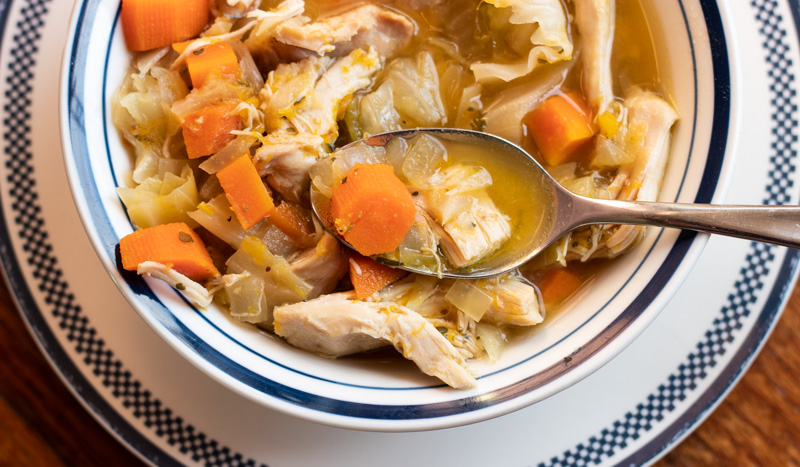
But one day, I grated a little parmesan over the top. Another time, I added a swirl of olive oil. Once I threw in a chunk of sourdough I had lying around and let it soak at the bottom. And each time, the soup got better — not because the recipe changed, but because the way I served it did.
This soup doesn’t need flash. But it benefits from attention.
A spoonful of yogurt or sour cream? Totally changes the mouthfeel. Balances the acid, adds creaminess without turning it into something heavy. Just one dollop, stirred in or left on top.
A drizzle of good olive oil? Gives the surface a little sheen, brings a bit of roundness to each bite. Especially if your broth runs lean or you went all-vegetable with the base.
Grated cheese — sharp cheddar, aged parmesan, even something nutty like gruyère — takes the whole bowl in a different direction. It anchors the broth, gives it weight. Suddenly you’re not just sipping hot vegetables, you’re eating something that clings to the spoon.
And don’t sleep on herbs. A handful of chopped parsley or dill at the end brightens the whole bowl. Same goes for scallions, if you want a little zip. The trick is not adding them to the pot — just the bowl. Let them stay fresh and loud.
Sides? You don’t need much. A piece of bread, toasted or torn. Crackers if you’re keeping it plain. If the soup’s thick and rich, something crunchy on the side balances it. If the soup’s light and clean, something fatty or warm helps ground it.
And if your soup came out a little thin, a quick trick: blend a small ladle of the cooked veggies and stir it back in. Thickens the broth just enough to give it body without losing the integrity of the whole pot.
The goal isn’t to dress up cabbage soup like it’s something it’s not. It’s to let it feel finished. Like someone cooked it with care, and served it with the same.
Next: leftovers. Why cabbage soup often tastes better the next day, how to store it without wrecking the texture, and what to do when you’ve got just enough left for one bowl but want it to feel new again. Let’s close the kitchen.
Leftovers, Freezing, and Next-Day Flavor
Cabbage soup changes overnight. What started out as clean and brothy picks up weight. The broth deepens. The vegetables settle into themselves. The acid softens. It’s like everything finally agrees to work together — and the second bowl tastes like it was always supposed to be this way.
But not if you screw up the storage.
First: let it cool properly. Don’t ladle it into a container while it’s still steaming hot. Let the pot rest uncovered for 20–30 minutes. It cools the soup gradually, prevents overcooking from residual heat, and keeps the cabbage from turning to mush by morning.
Transfer it to a container with a tight-fitting lid, ideally in a wide, shallow container instead of something tall and narrow. That helps it cool faster and prevents the “vegetable soup smell” from turning your entire fridge into a gas station lunchbox.
In the fridge, cabbage soup holds up for 3 to 4 days. The flavor improves during the first 24 hours, then starts to taper off after that. You’ll know it’s done when the broth starts tasting flat or the cabbage turns too soft to bite.
In the freezer, it’s good for about 1 to 2 months. But texture shifts are real. Cabbage gets softer. Potatoes (if you used them) might go grainy. Still, it’s worth freezing if you’ve got a big batch. Just leave a little headroom in the container — soup expands, and frozen tomato broth on your freezer shelf is not how you want to start your week.
Reheating should always be gentle. Low heat on the stovetop is best. Add a splash of water or broth if it’s thickened more than you like. Stir gently. Don’t boil it — that’s how you turn a rich, second-day soup into shredded cabbage in hot juice.
If you’re reheating in the microwave, do it in short bursts. Stir between each. Cover loosely. And if you’re microwaving in a container that still has the lid clicked on tight, I don’t know what to tell you. You’ve chosen chaos.
And if you’ve only got one bowl left and don’t want it to feel like leftovers? Dress it up. Add a handful of rice. Throw in cooked sausage. Grate some cheese over the top. Give it a toasted slice of bread and an egg. Suddenly it’s not what’s left — it’s what’s next.
FAQ — Slow Cooker Cabbage Soup
Cabbage soup doesn’t seem like it should raise questions — until you’re standing over the slow cooker wondering if it’s supposed to smell like that, or if the broth’s ever going to get thicker, or whether adding sausage now will ruin everything. This is the part of the recipe that answers the things most guides leave out.
Can I make cabbage soup without broth?
Technically, yes — you can use water. But you’ll need to build flavor in other ways: tomato paste, soy sauce, vinegar, garlic, herbs. Plain water will give you cabbage liquid, not soup. You can do it. You just have to work harder for the payoff.
Why does my cabbage soup smell so strong?
Because you’re cooking cabbage. It’s sulfurous, especially when slow-cooked. That’s not a sign something went wrong. Ventilate the kitchen, crack a window, and add a splash of vinegar near the end — it tames the aroma and balances the flavor.
How do I fix broth that’s too thin?
You’ve got a few options: let it cook uncovered for the last 30 minutes to reduce, or blend a ladleful of soup (with the veggies) and stir it back in. You can also stir in a spoonful of tomato paste or mashed beans to give it more body. Don’t thicken it with flour or cornstarch — it’ll just turn the broth gummy.
Can I cook it overnight?
Not recommended. Cabbage gets too soft, and aromatics can dull out after too long. Better to prep everything the night before, refrigerate it in the insert, and start the cooker in the morning.
What protein can I add that won’t dry out?
Sausage (pre-cooked or fresh and browned first), chickpeas, or shredded rotisserie chicken added at the end all work well. Ground meat can work too, but cook and season it separately so it doesn’t wash out the broth.
Can I blend the soup?
Sure — but it becomes a different dish. If you want to blend it, reserve some of the cabbage and vegetables first, then blend the base and stir the chunky bits back in. Pureeing the whole thing gives you something smooth and hearty, but less nuanced.
Cabbage soup isn’t fragile — but it does have its own rhythm. Most problems come from rushing it, skipping the base, or forgetting to taste along the way. When it’s done right, it’s a clean, satisfying bowl of food with way more depth than people give it credit for. And when it’s not? It’s still soup. You’ve got time to fix it.
Here’s the closing — no grand send-off, no over-explaining. Just the kind of quiet finish that fits a soup like this.
Closing: Cabbage Soup Isn’t Fancy — But It’s Real
There’s nothing flashy about cabbage soup. It doesn’t show off. It doesn’t pretend to be more than it is. But when it’s cooked with care — good broth, right timing, proper seasoning — it lands. It fills a bowl without weighing you down. It feeds a lot without costing much. And it gives back more than you’d think for a meal that starts with a head of cabbage and a half-cleaned-out fridge.
Here’s the closing — no grand send-off, no over-explaining. Just the kind of quiet finish that fits a soup like this.
Closing: Cabbage Soup Isn’t Fancy — But It’s Real
There’s nothing flashy about cabbage soup. It doesn’t show off. It doesn’t pretend to be more than it is. But when it’s cooked with care — good broth, right timing, proper seasoning — it lands. It fills a bowl without weighing you down. It feeds a lot without costing much. And it gives back more than you’d think for a meal that starts with a head of cabbage and a half-cleaned-out fridge.
Closing: Cabbage Soup Isn’t Fancy — But It’s Real
There’s nothing flashy about cabbage soup. It doesn’t show off. It doesn’t pretend to be more than it is. But when it’s cooked with care — good broth, right timing, proper seasoning — it lands. It fills a bowl without weighing you down. It feeds a lot without costing much. And it gives back more than you’d think for a meal that starts with a head of cabbage and a half-cleaned-out fridge.
It’s not a recipe that needs reinvention. Just respect. Treat it right, and it becomes something you come back to — not because it’s trendy, but because it’s yours.